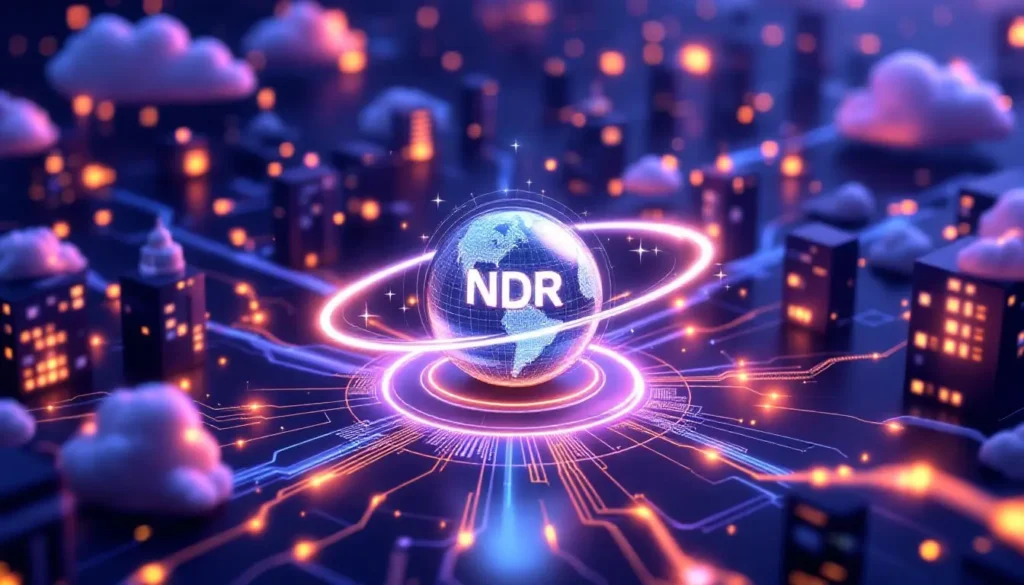Network Detection and Response (NDR) is a cybersecurity technology that continuously monitors network traffic to detect and respond to suspicious activity. Unlike traditional tools that focus on endpoints (like EDR) or logs (like SIEM), NDR looks directly at network data — the “digital bloodstream” of an organization.
By analyzing packets, flows, and communications between devices, NDR identifies anomalies, malicious behaviors, and lateral movement that might indicate an ongoing or developing attack. It gives security teams visibility across on-premises, cloud, and hybrid environments — allowing them to detect threats that other tools might miss.
How NDR Works: The Core Components
NDR operates by continuously collecting and analyzing network traffic data. Its core capabilities include:
- Data Collection and Traffic Analysis
NDR solutions passively capture network traffic — often using sensors, mirrors, or taps — to monitor every connection and data transfer across the infrastructure. This includes both north-south traffic (in and out of the network) and east-west traffic (between internal systems). - Behavioral Analytics and Machine Learning
Instead of relying on static signatures, NDR uses machine learning (ML) and behavioral analytics to establish a baseline of normal activity. Once the baseline is established, any deviation — like an unusual file transfer, a strange port communication, or a suspicious login attempt — is flagged for investigation. - Threat Detection and Correlation
NDR solutions correlate network anomalies with threat intelligence feeds, known attack patterns, and contextual data from SIEM or EDR systems. This correlation helps identify both known and unknown threats, including zero-day attacks and insider activity. - Response and Automation
When a threat is detected, NDR can automatically trigger response actions — such as isolating infected devices, blocking malicious IPs, or alerting the Security Operations Center (SOC). Many modern NDR solutions integrate with SOAR (Security Orchestration, Automation, and Response) and XDR (Extended Detection and Response) platforms for coordinated, automated defense.
Why NDR Is Critical in 2025
As networks become more complex — spanning cloud, on-premises, and remote environments — visibility has become the cornerstone of effective cybersecurity. NDR provides that visibility by monitoring every packet and connection in real time.
Here are some key reasons why NDR is transforming cybersecurity in 2025:
- Full Network Visibility: NDR eliminates blind spots, ensuring continuous monitoring across distributed environments.
- Faster Threat Detection: With AI and ML, NDR identifies anomalies in seconds, drastically reducing Mean Time to Detect (MTTD).
- Reduced False Positives: Intelligent analytics minimize alert noise, allowing analysts to focus on genuine threats.
- Enhanced Incident Response: Automated playbooks enable faster containment and recovery during active attacks.
- Cloud and Hybrid Security: Cloud-native NDR extends protection across AWS, Azure, Google Cloud, and hybrid infrastructures.
NDR vs. Other Detection Technologies
NDR services is often compared with EDR (Endpoint Detection and Response) and SIEM (Security Information and Event Management). While all three play vital roles, they serve different purposes:
- EDR monitors activities on individual devices (endpoints).
- SIEM aggregates and analyzes logs from multiple systems.
- NDR focuses on network traffic and communication patterns.
Together, these tools form a comprehensive detection and response ecosystem, with NDR providing the essential visibility layer that connects everything.
The Role of AI in Modern NDR
Artificial Intelligence (AI) is revolutionizing NDR by enabling real-time analysis at massive scale. AI-powered NDR platforms can:
- Detect unknown or zero-day threats through anomaly detection.
- Correlate seemingly unrelated events across the network.
- Predict potential attack paths using historical and behavioral data.
- Automate response actions without human intervention.
As attackers increasingly use AI to evade detection, AI-driven NDR ensures defenders can respond with equal — or greater — sophistication.
Conclusion: NDR — The Backbone of Proactive Cyber Defense
In an age where threats are faster, stealthier, and more persistent, Network Detection and Response provides the visibility and intelligence organizations need to protect their digital ecosystems. It’s not just about detecting attacks — it’s about anticipating, understanding, and neutralizing them before they cause harm.
As we move deeper into 2025, NDR services is no longer optional — it’s essential. By combining continuous network monitoring, AI-driven analytics, and automated response, NDR is redefining cybersecurity from the ground up, transforming reactive defense into proactive resilience.


